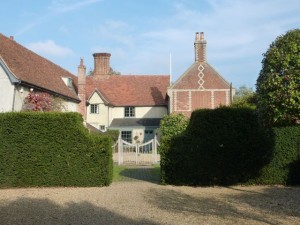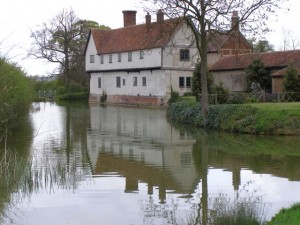
Tucked away in Suffolk behind rape fields and not far from ribbon development bungalows. The house takes its name not from the flower but by way of ancient association with the Norman family of de Columbers who owned the feudal manor in the 13C. Moated houses are common in this part of England but this one is remarkable in the vertiginous way that the timber framed house – substantial and interesting, rises up from its watery surroundings – the moat wraps itself almost entirely round the house – one remaining sliver of land creates a bridge in. House and platform (the official term for land enclosed by the moat) stand impregnable in the middle.
The present owners have lived here for 14 odd years and with the professional expertise of George Carter and the full-time gardener Kate have made a dauntingly perfect garden. There are strict principles employed – the first notable one is the sense of grand entrance on arrival. The farm buildings have been busted through so that a straight drive takes you on a journey through the former yard and in over the moat to arrive and park near the house. Symmetry rules – yew hedges and trees are planted in avenues or matched pairs. Your view is focused on the house, inviting behind thick wood gate and fence. It’s a lesson in how to arrive. So often the drive in can land the visitor in a parking lot with no view of the house at all.

On the way in, a ‘house style’ has been created so that the timbers used for bridge, gates and so on have the same sharp finials atop. As I walked round, this was echoed all over the garden and the obelisks in the sumptuous walled vegetable garden are painted verdigris, the same colour then appeared again in the strict avenues of the platform garden. There is a lot going on here at Columbine with so many vistas, views and different bits of garden that this echo of sameness is doubly important to stamp unity on the grounds.
The methods of this designer are very formal, historical and Columbine’s little brochure makes reference to 17
th style so we are talking le Notre and Hampton court – straight lines and grandiose but what could be pretentious is saved by a very careful reference to the landscape beyond. For example the east side of the house looks onto the formal grid of pleached limes and planting is paired down to long rectangular beds, timber edged, and the grandly named Allee. The grass is mown into wide paths but what really makes it work is the fact that as you get near to the moat, long grass with cow parsley is left unkempt and the fat Maran hens are allowed to wander. All fades in blurred edges back into nature.
The other point about the garden is the journey that you are invited to make round the house, either down the lime walk or through the wilderness – the path leads through a bog garden which makes the most of an aspect with no view. And so you are kept busy with things to distract – the circuit completes itself with the Moat walk and the house seen from its really knockout side, reflected upside down even on an overcast day.
 Tucked away in Suffolk behind rape fields and not far from ribbon development bungalows. The house takes its name not from the flower but by way of ancient association with the Norman family of de Columbers who owned the feudal manor in the 13C. Moated houses are common in this part of England but this one is remarkable in the vertiginous way that the timber framed house – substantial and interesting, rises up from its watery surroundings – the moat wraps itself almost entirely round the house – one remaining sliver of land creates a bridge in. House and platform (the official term for land enclosed by the moat) stand impregnable in the middle.
The present owners have lived here for 14 odd years and with the professional expertise of George Carter and the full-time gardener Kate have made a dauntingly perfect garden. There are strict principles employed – the first notable one is the sense of grand entrance on arrival. The farm buildings have been busted through so that a straight drive takes you on a journey through the former yard and in over the moat to arrive and park near the house. Symmetry rules – yew hedges and trees are planted in avenues or matched pairs. Your view is focused on the house, inviting behind thick wood gate and fence. It’s a lesson in how to arrive. So often the drive in can land the visitor in a parking lot with no view of the house at all.
Tucked away in Suffolk behind rape fields and not far from ribbon development bungalows. The house takes its name not from the flower but by way of ancient association with the Norman family of de Columbers who owned the feudal manor in the 13C. Moated houses are common in this part of England but this one is remarkable in the vertiginous way that the timber framed house – substantial and interesting, rises up from its watery surroundings – the moat wraps itself almost entirely round the house – one remaining sliver of land creates a bridge in. House and platform (the official term for land enclosed by the moat) stand impregnable in the middle.
The present owners have lived here for 14 odd years and with the professional expertise of George Carter and the full-time gardener Kate have made a dauntingly perfect garden. There are strict principles employed – the first notable one is the sense of grand entrance on arrival. The farm buildings have been busted through so that a straight drive takes you on a journey through the former yard and in over the moat to arrive and park near the house. Symmetry rules – yew hedges and trees are planted in avenues or matched pairs. Your view is focused on the house, inviting behind thick wood gate and fence. It’s a lesson in how to arrive. So often the drive in can land the visitor in a parking lot with no view of the house at all.
 On the way in, a ‘house style’ has been created so that the timbers used for bridge, gates and so on have the same sharp finials atop. As I walked round, this was echoed all over the garden and the obelisks in the sumptuous walled vegetable garden are painted verdigris, the same colour then appeared again in the strict avenues of the platform garden. There is a lot going on here at Columbine with so many vistas, views and different bits of garden that this echo of sameness is doubly important to stamp unity on the grounds.
The methods of this designer are very formal, historical and Columbine’s little brochure makes reference to 17th style so we are talking le Notre and Hampton court – straight lines and grandiose but what could be pretentious is saved by a very careful reference to the landscape beyond. For example the east side of the house looks onto the formal grid of pleached limes and planting is paired down to long rectangular beds, timber edged, and the grandly named Allee. The grass is mown into wide paths but what really makes it work is the fact that as you get near to the moat, long grass with cow parsley is left unkempt and the fat Maran hens are allowed to wander. All fades in blurred edges back into nature.
The other point about the garden is the journey that you are invited to make round the house, either down the lime walk or through the wilderness – the path leads through a bog garden which makes the most of an aspect with no view. And so you are kept busy with things to distract – the circuit completes itself with the Moat walk and the house seen from its really knockout side, reflected upside down even on an overcast day.
On the way in, a ‘house style’ has been created so that the timbers used for bridge, gates and so on have the same sharp finials atop. As I walked round, this was echoed all over the garden and the obelisks in the sumptuous walled vegetable garden are painted verdigris, the same colour then appeared again in the strict avenues of the platform garden. There is a lot going on here at Columbine with so many vistas, views and different bits of garden that this echo of sameness is doubly important to stamp unity on the grounds.
The methods of this designer are very formal, historical and Columbine’s little brochure makes reference to 17th style so we are talking le Notre and Hampton court – straight lines and grandiose but what could be pretentious is saved by a very careful reference to the landscape beyond. For example the east side of the house looks onto the formal grid of pleached limes and planting is paired down to long rectangular beds, timber edged, and the grandly named Allee. The grass is mown into wide paths but what really makes it work is the fact that as you get near to the moat, long grass with cow parsley is left unkempt and the fat Maran hens are allowed to wander. All fades in blurred edges back into nature.
The other point about the garden is the journey that you are invited to make round the house, either down the lime walk or through the wilderness – the path leads through a bog garden which makes the most of an aspect with no view. And so you are kept busy with things to distract – the circuit completes itself with the Moat walk and the house seen from its really knockout side, reflected upside down even on an overcast day. 